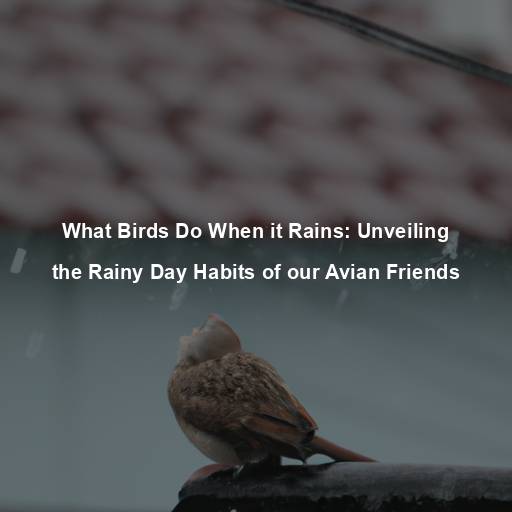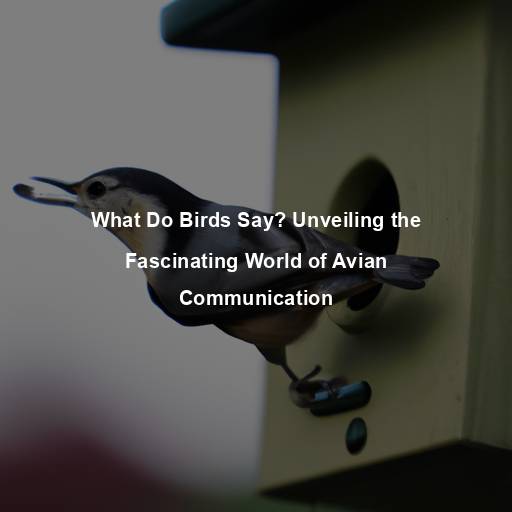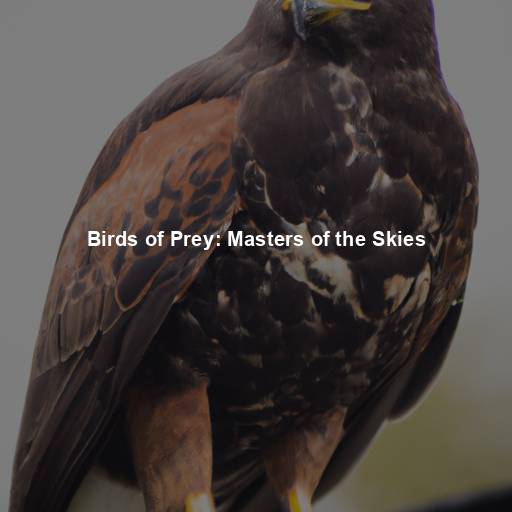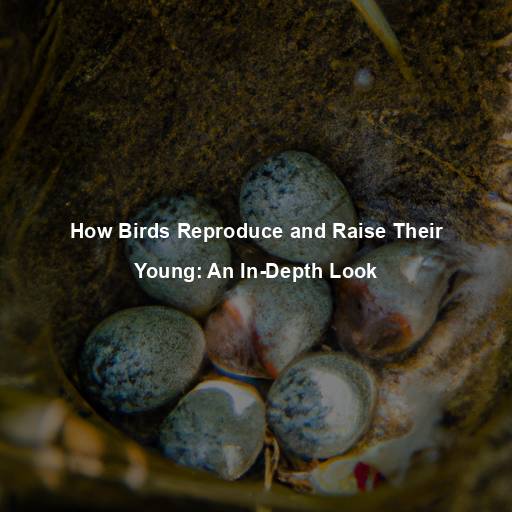What Birds Do When it Rains: Unveiling the Rainy Day Habits of our Avian Friends
Last Updated on August 5, 2023 by Evan
Contents [hide]
- 1 Understanding the Rainy Day Routines of Birds
- 1.1 Rainy Day Hideouts: Seeking Shelter from the Storm
- 1.2 Rainy Day Survival: Adaptations and Strategies
- 1.3 Birdsong in the Rain: The Melodious Rain Choruses
- 1.4 Rainy Day Challenges: Overcoming Obstacles
- 1.5 A Fascinating Glimpse into Avian Resilience
- 1.6 Rain as a Catalyst for Feeding Opportunities
- 1.7 Rain-triggered Migration Behavior
- 1.8 Rain’s Influence on Breeding Behavior
- 1.9 Rain’s Impact on Bird Communication
- 2 A Rainy Symphony: Nature’s Synchrony
- 3 FAQs on What Birds Do When It Rains
- 3.1 What do birds do when it rains?
- 3.2 How do birds stay dry during rainfall?
- 3.3 Do birds take baths or drink rainwater during rain?
- 3.4 Do birds fly during rainstorms?
- 3.5 How do birds find food during rainy weather?
- 3.6 How do birds protect their nests and eggs from rain?
- 3.7 Do birds sing in the rain?
Understanding the Rainy Day Routines of Birds
Have you ever felt curious about how our feathered companions deal with rainy days? It’s truly fascinating how birds showcase their adaptability and ingenuity when faced with the challenges that come with rain. Together, let’s explore the intriguing realm of avian behavior during wet weather, discovering the exceptional habits and survival tactics that these remarkable creatures employ to maneuver through the tempestuous storm. Join us on this captivating journey into the unknown depths of birds’ rain-filled lives.
Rainy Day Hideouts: Seeking Shelter from the Storm
As the raindrops begin to fall, birds instinctively seek refuge in different types of shelters. Here are some common hideouts birds choose when rain threatens their comfort:
In the heart of nature’s embrace lies the secret to staying dry – the lush tapestry of thick foliage. The intricate network of dense vegetation, from towering trees to intricate shrubs, acts as a shield against the relentless raindrops. A sanctuary for feathered creatures, who navigate the labyrinthine branches, seeking solace and shelter beneath the broad, leafy canopies that serve as nature’s own umbrellas.
In the enchanting world of avian abodes, nest cavities reign supreme. A multitude of bird species grace these hollow havens, whether they meticulously craft their own or stumble upon a preexisting dwelling within the ancient branches. These nooks, tucked away within nature’s embrace, provide a sanctuary from the capricious whims of rainfall, ensuring our feathered friends remain dry and shielded from the watery perils that loom above.
Birds, true masters of adaptation, have their secret gathering places known as roosting sites. These chosen spots, often nestled amidst the dense foliage of evergreen trees, serve as havens during harsh weather conditions. Here, they huddle together, embracing warmth and finding solace from the relentless downpour and biting winds.
- Man-Made Structures: Birds have adapted to urban environments and may seek refuge under building eaves, bridges, or in the nooks and crannies of human-made structures when natural shelters are scarce.
Rainy Day Survival: Adaptations and Strategies
Rain can be a formidable opponent for our feathered friends, but fear not, for birds have evolved some truly awe-inspiring methods to conquer this watery challenge. From the way they preen their feathers to create a natural umbrella, to their ability to take advantage of rain showers for hunting opportunities, these airborne creatures have some truly mind-boggling tactics up their wings. Join us on a journey of discovery as we unveil the elusive secrets of avian rain survival.
Feather Care: Delving into the world of avian personal grooming, one cannot help but marvel at the mysterious art of feather maintenance. These delicate adornments, so much more than mere ornamentation, hold the key to a bird’s survival in a watery world. Through a complex dance of aligning, cleaning, and secreted oils, our feathered friends navigate the realm of waterproofing and temperature regulation, leaving us in awe of their intricate routines.
-
Tucked Beaks: To prevent rain from entering their beaks and airways, birds tuck their beaks under their feathers. This positioning not only keeps their delicate respiratory system dry but also prevents water from impairing their vision.
-
Reduced Activity: During heavy downpours, birds often reduce their activity levels, conserving energy and minimizing exposure to the rain. By perching quietly and waiting for the rain to subside, birds can avoid the risks associated with flying or foraging in adverse weather conditions.
-
Foraging Opportunities: Rainy days can present unique foraging opportunities for birds. As rainwater collects on leaves and flowers, birds may indulge in “leaf bathing” or “flower bathing,” where they flutter and splash around in the water, extracting essential nutrients and minerals from the wet foliage.
Birdsong in the Rain: The Melodious Rain Choruses
Contrary to popular belief, rain does not silence the sweet melodies of birds. In fact, some birds actively sing during rainfall, creating a symphony amidst the raindrops. Here’s why:
In the wild world of avian interactions, raindrops become a stage for territorial communication. When the skies pour down, birds take the opportunity to flex their vocal cords, asserting their presence with melodic intensity. With each raindrop that falls, boundaries are defined, nest sites are protected, and potential mates are lured into their mesmerizing courtship symphony. A perplexing phenomenon of nature, where the rain becomes an unexpected ally in the survival of the fittest.
- Masking Effect: The sound of rain can mask other environmental noises, providing a unique opportunity for birds to communicate without interference. Rainy days offer an acoustic advantage, allowing their songs to carry further distances than on dry days.
Imagine the enchantment of a bird’s song, so intricately woven with the symphony of raindrops. Some avian virtuosos have ingeniously incorporated the delicate pitter-patter of rain into their melodic repertoire, blending the rhythms of nature into their enchanting serenades. With each drop that cascades from the sky, these feathered musicians capture the ethereal essence of rainfall, bewitching our ears with their mesmerizing performances. Experience the awe-inspiring beauty as these avian maestros harmonize with the rain, creating a symphony that astounds and perplexes all who have the fortune to listen.
Rainy Day Challenges: Overcoming Obstacles
Birds are incredible creatures that have developed fascinating ways to deal with the unpredictable nature of rain. However, even with their remarkable adaptations, they are not exempt from the trials that come with damp conditions. Join us as we delve into the myriad challenges that birds must navigate when faced with rainy days.
With the advent of rainfall, a perplexing phenomenon unfurls in the natural world. The once vibrant symphony of buzzing insects diminishes, leaving a void in the daily lives of avian creatures reliant on these morsels. Thus, the feathered inhabitants find themselves entangled in a burst of uncertainty, forced to adapt their feeding habits or conserve their energy in the face of this enigmatic downturn in their insectivorous feast.
Rain can be a real feather ruffler for our avian friends! While birds are equipped with waterproof feathers, extended exposure to precipitation can cause these plumage to become cumbersome, making it quite the challenge for them to take flight. It’s a delicate balancing act, as they must navigate their way through rainfall with utmost care to prevent any adverse effects on their ability to soar through the skies.
When the skies unleash their watery fury, little do we ponder the precarious predicament that befalls our feathered friends. For nestled high up on branches or perched vulnerably in open spaces, bird nests become unwitting victims of nature’s tumultuous tantrums. Imagine the plight of these tiny dwellings as torrents of rain flood their humble chambers, leaving behind a dampened abode for fragile eggs or a treacherous terrain for the delicate hatchlings. Such nesting challenges, shrouded in a perplexing symphony of uncertainty and vulnerability, require our mindful contemplation.
A Fascinating Glimpse into Avian Resilience
As we peer into the mysterious world of avian life on wet and gloomy days, we are granted a remarkable glimpse into their resilience and remarkable capacity to acclimate to their environments. Though rain may present formidable obstacles, birds have steadily refined their survival tactics across countless generations, ensuring their triumphant presence in a vast array of habitats spanning the globe. So, when droplets of rain descend from the heavens, let us pause for a moment to observe our winged companions, astounded by their adaptability and steadfast resolve to flourish, regardless of the tearful skies above.
Rain as a Catalyst for Feeding Opportunities
Rain can be both a blessing and a curse for our feathered friends. While it may dampen their feathers and make for a slippery affair, it also bestows upon them a tantalizing smorgasbord of culinary delights. As the heavens open up, the birds take to the skies with an air of perplexity, unsure of where their next meal might come from. In this intricate dance of chance and spontaneity, they artfully navigate the showers, swooping down on unsuspecting earthworms and insects, transforming a gloomy day into a burst of feeding frenzy.
Rain-Induced Insect Emergence
Rainfall often triggers the emergence of insects, as it provides the necessary moisture for their development. This sudden abundance of insects can be a feast for insectivorous birds. They take advantage of this bounty by actively foraging and capturing insects that are more readily available during and after rain showers.
Opportunistic Foraging
Rainfall can also lead to the displacement of small invertebrates, such as worms and snails, from the soil. These creatures become more accessible to birds as they surface to avoid drowning. Birds with probing beaks, like thrushes and robins, utilize this opportunity to search for earthworms and mollusks in the dampened soil.
Fruit and Nectar Consumption
For frugivorous and nectar-feeding birds, rain can affect the availability and quality of their food sources. Rainfall can cause fruits to ripen and fall from trees, providing a nutritious and easily accessible food supply. Similarly, nectar-producing flowers may produce more abundant nectar during or after rain, attracting hummingbirds and other nectar-feeding species.
Rain-triggered Migration Behavior
Bird migration is a captivating natural phenomenon that is intricately linked to the ever-changing nature of rainfall. The enigmatic dance between raindrops and winged creatures creates a perplexing tapestry of behavior and patterns that continue to captivate researchers and bird enthusiasts alike. From altering flight routes to determining breeding grounds, rain’s elusive touch on avian migration remains an intriguing puzzle waiting to be unraveled. So, let us embark on a journey through the ethereal realm of bird migration, where the whims of rain lead us down a path of both splendor and intrigue.
Weather Systems and Migration Timing
Have you ever wondered how birds manage to navigate thousands of miles with such precision? It turns out that they have a secret weapon – the weather! In a stunning display of adaptability, birds have the ability to time their migrations based on the ever-changing weather patterns. From gentle showers that help them conserve energy to powerful storms that force them to reroute their journey, these feathered adventurers are constantly monitoring the sky for clues.
Rest and Refueling Stops
During migration, birds rely on stopover sites to rest and refuel before continuing their journey. Rainy weather can have a profound impact on these stopovers. Prolonged rain can provide much-needed water sources for drinking and bathing, while wet vegetation may harbor an increased number of insects, providing a valuable food source for migrating birds.
Coastal and Wetland Habitats
The delicate interplay between coastal and wetland habitats and migratory birds is a captivating dance of survival and sustenance. Nature’s whimsical rainfall holds the power to sway the very fabric of these ecosystems, shaping the availability and salinity of vital water sources and thus dictating the abundance and distribution of aquatic life. Instinctively attuned to this beautiful yet perplexing symphony, these birds orchestrate their arrival to coincide with moments of heightened productivity, ensuring a bountiful feast for both themselves and their precious nestlings. It is within these intricate tapestries of life that the true marvel of nature’s enigmatic design unfurls.
Rain’s Influence on Breeding Behavior
The fascinating world of avian breeding behavior is shaped by the whims of rainfall, which can bring a wave of perplexity and uncertainty for our feathered friends. As droplets fall from the heavens, they create a symphony of burstiness, sending ripples through the delicate tapestry of bird family planning. From altering the timing of mating rituals to affecting the availability of crucial resources, rain holds the power to both disrupt and mold the reproductive cycle of our avian companions. So, let’s delve into the intriguing ways in which rain can sway the fortunes of nesting birds, unraveling the mysteries hidden within this intricate dance of life.
Nest Building and Maintenance
As the skies unleash their watery forces, birds face a tumultuous test during their meticulous nest-building endeavors. The relentless downpours, like unpredictable adversaries, bring forth both trials and triumphs. On one hand, the deluge threatens to erode the very foundations of their carefully constructed havens or renders the search for sturdy materials an arduous mission. Yet, amidst the chaos, rain bestows an unexpected gift – a precious moisture-laden ally that enables birds to sculpt and fashion their nests into safe, snug sanctuaries for their delicate eggs and vulnerable hatchlings.
Incubation and Parental Care
During the incubation period, birds must carefully balance the need to keep their eggs warm and dry. Rainy weather can increase the risk of egg chilling and waterlogging in the nest. To protect their eggs, birds may adjust their incubation behavior, such as increasing the amount of time they spend on the nest or employing waterproofing techniques to shield the eggs from moisture.
Chick Development and Food Availability
The ever-changing rhythm of rainfall dances with nature’s grand design, orchestrating a crucial symphony for the nourishment of growing chicks. A cascade of droplets from the heavens, this liquid lifeblood shapes the very fabric of our feathery friends’ existence. Delighting in the abundance it brings, insects buzz and flutter, their tiny wings a sumptuous feast for voracious beaks. Yet, as the skies withhold their tears or unleash them with relentless fury, the delicate equilibrium crumbles, leaving the future of these young birds hanging precariously in the balance.
Rain’s Impact on Bird Communication
Birds are truly fascinating creatures, and their ability to communicate through sound is a wonder of the natural world. But what happens when rain enters the picture? It turns out that rainfall can throw a wrench in their vocal interactions and mating rituals, creating a perplexing scenario for these feathered friends. In this article, we’ll dive into the world of bird communication and uncover the intriguing ways in which rain affects their acoustic signals, leading to a burst of both confusion and curiosity.
Altered Sound Propagation
The fascinating interaction between rainfall and sound waves never fails to intrigue us. With each drop of rain, the acoustic conditions experience a perplexing transformation, altering the way sound travels and echoes through the air. One intriguing consequence of this delightful dance is the impact it has on our feathered friends – birds. As raindrops cascade from the heavens, they possess the power to muffle and dampen bird songs, creating a burst of uncertainty in their communication across vast distances.
Amplified Vocal Performances
Birds have a secret melodic strategy up their feathers – raindrops become their backing choir. The tranquility of rainfall on leaves and surfaces acts as a natural amplifier for their enchanting songs, ensuring their melodies reach distant ears. This delightful phenomenon becomes a joyful tool for wooing potential partners and claiming territories with a perplexing burst of musical prowess.
Visual Displays and Courtship Rituals
In addition to vocal communication, birds often rely on visual displays and courtship rituals to attract mates. Rainy weather may alter the timing or intensity of these displays. Some bird species engage in elaborate courtship dances during or after rainfall, utilizing the wet environment to showcase their vibrant plumage or impressive physical abilities.
A Rainy Symphony: Nature’s Synchrony
As we delve into the intricate world of birds and rain, it becomes evident that the relationship between these two elements is a harmonious symphony. Rain, though it may present challenges, also brings forth a myriad of opportunities and influences various aspects of bird behavior. Whether seeking shelter, foraging for food, navigating migrations, tending to their young, or communicating with one another, birds adapt and respond to the rhythm of rainfall in remarkable ways. Let us marvel at the resilience and ingenuity of our avian friends, finding inspiration in their ability to thrive even in the face of nature’s tears.
FAQs on What Birds Do When It Rains
What do birds do when it rains?
When the skies unleash their watery wrath, our avian friends showcase their exquisite adaptability. A symphony of strategies unfolds, as these feathered marvels navigate the perplexing realm of rain. Some take refuge amidst nature’s verdant shelter – majestic trees and foliage, where they seek solace beneath the protective embrace of leaves. Others, the trailblazers of resilience, braving the downpour with unwavering determination, their activities resiliently persevering. The rain, a catalyst for transformation, may cause some birds to recalibrate their routines, a temporary pause in their foraging or flight, a subtle adjustment in their splendid dance with the elements.
How do birds stay dry during rainfall?
When it comes to birds, it’s all about the feathers! These marvelous creatures have a secret weapon in the form of specialized feathers that have the power to insulate and repel water. But wait, there’s more – they even have their own natural oil, charmingly known as preen oil, that they apply diligently using their beaks. This magical elixir acts as a mystical shield, fending off any unwanted moisture from seeping through their feathers and reaching their delicate skin. And get this, folks – when rain begins to pour, these savvy birds go all out with their feather preening extravaganza, ensuring they remain as dry as a bone. Talk about bright minds in the animal kingdom!
Do birds take baths or drink rainwater during rain?
While some birds may take advantage of rain showers for a quick bath or to drink fresh rainwater, not all birds engage in this behavior. It largely depends on the bird species, their preferences, and the intensity of the rain. Additionally, some birds have adaptations that allow them to obtain moisture from their diet, so they may not rely on rainwater as heavily for hydration.
Do birds fly during rainstorms?
Birds will generally avoid flying during heavy rainstorms due to the challenges it presents. Flying in heavy rain can make it difficult for birds to see and navigate properly. Raindrops hitting their wings can also disrupt their flight patterns and decrease their agility. Therefore, it is more common to see reduced bird activity during rainstorms, with birds either seeking shelter or staying in covered areas until the rain subsides.
How do birds find food during rainy weather?
As the heavens weep, our feathered friends face a perplexing predicament – their usual delicacies are cloaked in obscurity or seek refuge themselves. But fret not, for these avian virtuosos possess an innate ability to navigate the tempestuous symphony of survival. They cleverly pivot, casting their sights upon a cornucopia of alternative nourishment – succulent fruits, bountiful seeds, and ephemeral insects that thrive in the embrace of dampened skies. Their acute auditory prowess becomes their guiding compass, unearthing subterranean morsels amidst the waterlogged soil.
How do birds protect their nests and eggs from rain?
When it comes to building their cozy abodes, birds truly display their ingenuity. The way they craft their nests is nothing short of remarkable, as they carefully select materials that serve as a protective shield against the unpredictable whims of rainfall. Twigs and leaves are cleverly arranged on the outer layers, cleverly diverting any water away from the precious nest cavity. The placement and shape of the nest are also strategic, working in harmony to minimize exposure to those pesky raindrops. Some bird species even go the extra mile, with nature-bestowed adaptations like canopy-like structures or overhangs, ensuring their nests remain dry havens even during the most perplexing and sudden downpours. And let’s not forget the dedication of these feathered parents, who sit tightly on their nests, using their own bodies to keep their precious eggs or chicks warm and dry when the rain showers arrive unexpectedly. It’s an awe-inspiring display of nature’s brilliance, reminding us of the intricate and bursty world these fascinating creatures inhabit.
Do birds sing in the rain?
Birds may continue to vocalize during light rain showers, but their songs and calls may be less frequent or modified due to the need for increased focus on survival and reduced visibility. However, during heavy rainfall, it is less common to hear birds singing as their attention shifts to seeking refuge from the adverse weather conditions. Once the rain has subsided, birds will likely resume their vocalizations as part of their territorial or courtship behaviors.







